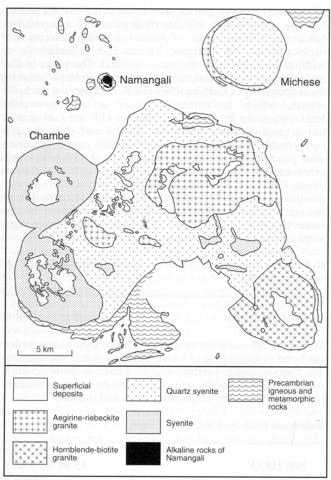stripes
Namagali forms a low hill of 1.7x1.4 km rising some 150 m above the surrounding Palombe Plain. The central eastern part of the hill is occupied by an elliptical vent of feldspathic breccias that form a crater-like depression. The rest of the hill is built of Precambrian basement rocks, most of which are fenitized. Both the fenites and the vent rocks are cut by numerous sheets of phonolitic and trachytic rocks, several breccia vents and a small area of carbonatite veins. The rocks of the main breecia vent have been increasingly feldspathised towards the centre. They consist of blocks and fragments from millimetre size up to 0.5 m of aegirine and arfvedsonite fenite, with in places trachyte and minor dolerite, which are gradually feldspathised the final product being an orthoclase rock, with some albite, which assumes a trachytic texture. There are several minor breccia vents that are filled with rocks similar to the less feldspathised rocks of the main vent. There are also four breccia bodies that Garson (1959) distinguishes as phonolitic breccia, the largest of which (approximately 300x200 m) occurs in the northwestern part of the main breccia vent, the others elsewhere in the vent. Fragments in these breccias include fenite, aegirine-orthoclase rock, leucotrachyte, phonolitic trachyte, several varieties of phonolite and microfoyaite and crystals of aegirine-augite, up to 5 cm long, in a phonolitic matrix. Leucotrachyte, apart from that caught up in the main vent, forms a circular intrusion on the northeastern margin of the main vent and a number of dykes cutting the fenites. It consists of phenocrysts of sanidine in a trachytic matrix of orthoclase and subordinate albite; there is minor, much altered, aegirine. Within some of the trachyte dykes there are local patches and veins of blue or clear sodalite. Phonolite forms dykes and consists of orthoclase phenocrysts in a fluidal matrix of orthoclase, aegirine and a little nepheline partly replaced by sodalite and calcite. A radial dyke on the northwestern side of the hill contains up to 60% aegirine, which is partly replaced by arfvedsonite, orthoclase and minor nepheline. The matrix of much of the feldspathic breccia of the main vent contains a little calcite but one small area on the southern edge of the vent contains a ramifying network of sovite veins up to 18 cm thick with replacement of the feldspathic matrix by carbonate. The sovite consists of granular calcite, aegirine, accessory apatite and sparse xenocrysts of orthoclase. Sovite veins were also noted on the edge of a mass of phonolitic breccia in the main vent, and these veins are distinguished by marginal zones of sodalite impregnating the adjacent breccia. The fenitization at Namangali extends for 400 to 500 m from the main breccia vent and involves the replacement of quartz and development of secondary aegirine, orthoclase and blue, fibrous sodic amphibole.
GARSON, M.S. 1959. Geology of the Namangali vent, Mlanje District. Records, Geological Survey of Malawi, 1: 51-62.


